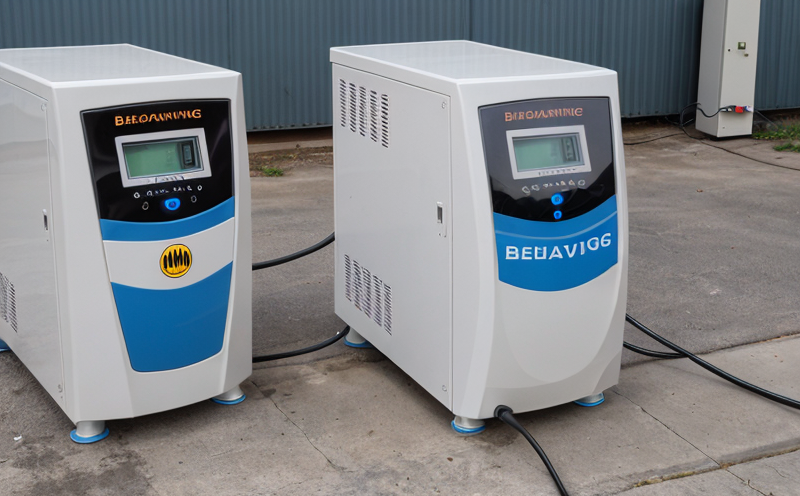IEC 63115 Charging and Discharging Behavior Testing of Stationary Lithium Batteries
The IEC (International Electrotechnical Commission) standard IEC 63115 is a globally recognized guideline that specifies the methods for testing the charging and discharging behavior of stationary lithium batteries. This service is crucial for ensuring battery safety, reliability, and performance in various applications such as energy storage systems (ESS), uninterruptible power supplies (UPS), and grid stabilization.
The primary goal of this testing is to evaluate how these batteries respond under different conditions during charging and discharging cycles. Understanding the behavior of lithium batteries is essential for optimizing their use, ensuring they operate safely over extended periods, and predicting potential failures before they occur.
During the testing process, a series of parameters are closely monitored including voltage, current, temperature, internal resistance, and capacity retention. These metrics provide valuable insights into how well the battery performs under various charging rates and discharge depths. The standard also considers the impact of environmental factors such as temperature and humidity on battery performance.
One key aspect of this testing is the evaluation of battery endurance through repeated charge-discharge cycles. This helps determine the battery's cycle life, which is critical for its long-term reliability in stationary applications. Additionally, the test assesses the safety features of the battery by monitoring temperature spikes and ensuring that all safety mechanisms function correctly.
The charging process itself can vary widely depending on the specific application requirements. For instance, in ESS systems, a slow but steady charge is often preferred to avoid overheating or stress on the battery. Conversely, for UPS applications, rapid charging might be necessary to ensure quick recovery from power outages. The discharging behavior is equally important as it reflects how much energy can be extracted from the battery under different load conditions.
Another critical factor in this testing is the initial state of charge (SOC) and the final state of discharge (SOD). These parameters help determine the efficiency and capacity retention of the battery over time. By maintaining precise control over these factors, we can ensure that the test results are as accurate as possible.
The instrumentation used for IEC 63115 testing is sophisticated and includes advanced battery management systems (BMS), data acquisition units, and real-time monitoring equipment. These tools provide real-time data on all critical parameters mentioned above, allowing us to make informed decisions during the test process.
- Ensures compliance with international standards
- Supports quality control and assurance programs
- Aids in R&D for new battery technologies
- Facilitates procurement of reliable components
This testing not only helps manufacturers meet regulatory requirements but also enhances the safety and performance of stationary lithium batteries. By adhering to IEC 63115, we contribute to a more sustainable energy future where batteries play a pivotal role in managing renewable energy sources.
Scope and Methodology
The scope of the testing outlined by IEC 63115 includes detailed procedures for simulating real-world charging and discharging scenarios. The methodology is designed to cover a wide range of conditions that stationary lithium batteries might encounter during their operational life.
The test begins with setting up the battery in its initial state, which involves determining the exact SOC before any testing commences. This ensures that all subsequent tests are conducted under consistent starting points. Once the initial setup is complete, the charging process starts at a specified rate, typically ranging from 0.1C to 3C depending on the application.
During the charging phase, various parameters such as voltage, current, and temperature are continuously monitored using high-precision instruments. The battery is subjected to different temperatures (both low and high) to assess its performance under varying environmental conditions. This step helps identify any thermal runaway risks which could lead to safety issues.
After reaching the predetermined end-of-charge criteria, the battery undergoes a rest period before commencing the discharge phase. The discharge process is carefully controlled to simulate real-world usage scenarios, including different depth of discharge (DoD) levels such as 20%, 50%, and 100%. The current drawn during each cycle is also monitored closely.
The testing continues until either a predetermined number of cycles have been completed or the battery reaches its end-of-life criteria. Throughout this process, data is collected and analyzed to provide detailed insights into the battery's performance characteristics. This information can then be used by manufacturers to improve their products further.
Customer Impact and Satisfaction
Adhering to IEC 63115 ensures that customers receive batteries that are safe, reliable, and perform optimally in their intended applications. Here’s how this testing impacts different stakeholders:
- Manufacturers: Compliance with the standard enhances brand reputation and market credibility.
- Quality Managers: It provides a robust framework for quality assurance programs.
- R&D Engineers: The detailed data collected can drive innovation in battery technology.
- Compliance Officers: Ensures adherence to international standards, avoiding potential legal issues.
- Procurement Teams: Helps identify reliable suppliers and components for their projects.
The satisfaction of our customers is paramount. By providing accurate, consistent test results that meet stringent international standards, we build trust and confidence in the reliability of our services. Our commitment to excellence ensures that every customer receives the best possible outcome from their testing needs.
International Acceptance and Recognition
The IEC 63115 standard is widely accepted across numerous countries due to its rigorous approach to evaluating stationary lithium batteries. It has been adopted by organizations such as IEEE, ANSI, and other national standards bodies worldwide.
Many governments and regulatory agencies use this standard when setting up guidelines for the safe deployment of stationary energy storage systems (ESS). Its global recognition makes it an essential tool for manufacturers who aim to sell their products internationally. By adhering to these stringent tests, they can ensure that their batteries meet all necessary requirements without additional certification processes.
The acceptance and recognition extend beyond just compliance; it also fosters a culture of continuous improvement among industry players. As new technologies emerge, the standard remains adaptable, ensuring that it continues to provide relevant guidance for testing future generations of stationary lithium batteries.





